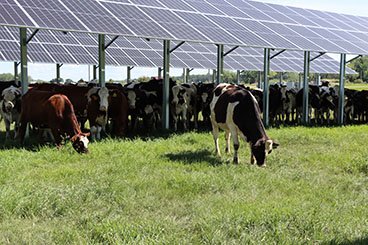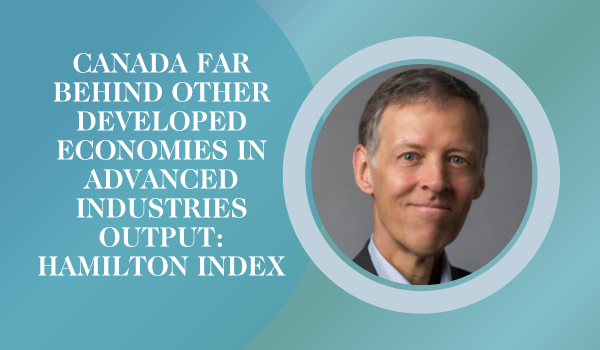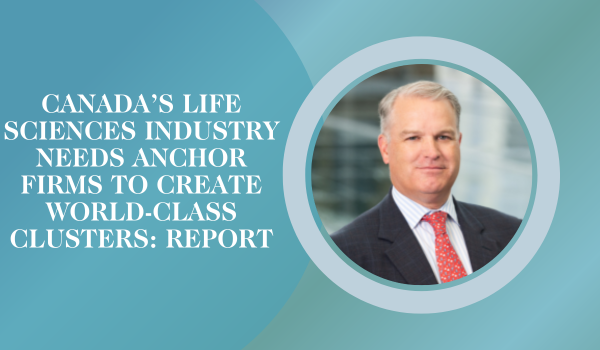Canada lacks coherent data on federal science workforce: Chief Science Advisor’s report
Ottawa employs more than 31,000 scientists – over 11 per cent of the federal workforce – but lacks coherent data to determine where they work, what their skillsets are and what they actually do, according to a report by the Office of the Chief Science Advisor.
 The report, “The Federal Science Workforce: An Overview,” raises questions about whether the government has sufficient information to determine if it has enough of the right type of scientists doing work in areas of critical strategic importance to the nation, said Dr. Mona Nemer, PhD (photo at right), Canada’s chief science advisor.
The report, “The Federal Science Workforce: An Overview,” raises questions about whether the government has sufficient information to determine if it has enough of the right type of scientists doing work in areas of critical strategic importance to the nation, said Dr. Mona Nemer, PhD (photo at right), Canada’s chief science advisor.
“The data doesn’t allow us to determine this,” Nemer told Research Money. “The most surprising aspect was the lack of coherent data, the fragmentation.”
Another surprising finding was that many previous reports had documented the problem and made recommendations to fix it, “but not much had been done,” she added.
“We’re not saying that the science workforce is not a competent one, that it’s not doing the jobs that are needed,” Nemer stressed.
But current federal data on the science workforce is so fragmented and unharmonized that her study had to exclude more than 23,000 employees categorized as working in economics and social sciences, “because we can’t figure out who’s really doing science versus who’s doing management,” she said.
“Without sufficiently detailed information on the Canadian government’s scientific programs and activities, it is difficult to judge whether the federal science workforce is adequately meeting the government’s needs,” Nemer’s report says.
It notes that federal scientists play a crucial role in shaping the public policies Canada chooses to deploy in response to current and future challenges, such as an aging population, food security issues and the fight against climate change and its impacts.
Moreover, Prime Minister Justin Trudeau’s Liberals made “evidence-based policy” a cornerstone of their platform when they were first elected to govern in October 2015.
Several previous reports that looked at the federal science workforce were produced between 1994 and 2022, by organizations that included: the Office of the Auditor General; Industry Canada; the Council of Science and Technology Advisors; the Science, Technology and Innovation Council; the Expert Advisory Group chaired by Ken Knox; and the Public Service of Canada.
“In essence, these reports concluded that the federal government must understand the characteristics of the federal science workforce and its importance in order to effectively fulfill its role as a vital player in the national innovation system,” Nemer’s report says.
While some shortcomings regarding the federal science workforce were frequently raised and many recommendations were made in previous reports, “it seems that few of these recommendations have been implemented. At the very least, it is difficult to assess progress without consistent information and data.”
“We do not know the precise number and distribution of scientists employed by the federal government, or who they are, or whether they are representative of the Canadian population,” her report notes.
According to her report’s analysis, more than five decades after reports first raised recurring issues related to managing the federal science workforce, there remains a need to:
- maintain a centralized and accessible data system on the federal science workforce.
- monitor and analyze science and technology labour market conditions in order to better plan the expertise and human resources required.
- benchmark the federal government’s research capacity against other countries and R&D sectors.
“Action is needed to collect data from the scientific workforce and to follow up on the many analyses and recommendations made in previous reports,” her report says.
Half of government departments lack a single scientist
Based on the available data that could be used for Nemer’s report, in March 2022, the federal science workforce consisted of 31,157 people, or 11.4 per cent of federal government employees.
Of these, 19,257 employees (61.8 per cent of the federal science workforce) were in STEM (science, technology, engineering, mathematics) positions; 10,897 (34.9 per cent), were in engineering and scientific support positions; and 1,021, (3.3 per cent), were health scientists including physicians, veterinarians, dentists and pharmacists.
“The government is both a consumer of science and a performer of science, which probably most Canadians don’t appreciate,” Nemer said.
Four federal departments and one federal agency each employed more than 3,000 scientists in March 2022. They were: Canadian Food Inspection Agency (4,265 scientists); Department of National Defence (3,809); Health Canada (3,777); Environment and Climate Change Canada (3,695); and Fisheries and Oceans Canada (3,151).
In comparison, the National Research Council (NRC) employed 2,388 scientists in March 2022. Natural Resources Canada had 1,773 scientists; Innovation, Science and Economic Development had 693 scientists; and the Public Health Agency of Canada had 680 scientists.
In no fewer than 17 departments and agencies, at least one employee in 10 was in a scientific position in March 2022. In particular, almost two out of every three employees at the Canadian Food Inspection Agency were scientists. This proportion increased to almost 50 per cent at the NRC and at Environment and Climate Change Canada.
However, Nemer said what is surprising, given the interdisciplinary nature of today’s daunting scientific and social challenges, “is that in the 21st century there are half of the departments within government that don’t have a single scientist.”
“I’m not here to advocate for more hiring within the public service,” she added. “But you’d think with all the hiring that has happened [in the federal civil service], we could have increased the representation of scientists.”
Nemer pointed out that Canada was confronted, during the COVID-19 pandemic, by not having a well-organized search capacity for life sciences expertise and emergency equipment within government departments and agencies. For example, at one point Canada was unable to do enough testing for COVID-19, because there weren’t enough people with the expertise to do the testing or enough testing equipment in labs.
“This is not the time, when we have an emergency, to start trying to find out where the scientists are and what they do,” Nemer said.
“If we think about climate-related disasters and environmental challenges, even if we think in terms of our international commitments in terms of biodiversity or climate change, it’s going to involve a lot of doing science and a lot of using science.”
Given such challenges, the government needs more experts in scientific content as well as more scientists and engineers to take on policy and managerial roles, such as director generals or assistant deputy ministers, Nemer said.
Several areas need improvement
Nemer’s report notes that previous reports looking at the federal science workforce identified several shortcomings, including:
- recruitment processes and hiring of new graduates
- management of training and development activities
- talent management, including career advancement, assignments and horizontal mobility within government
- collaboration, both within government and with industry and academia
- guidelines for and enabling of public communication by federal scientists
- existing data and statistics on the federal science workforce.
Earlier reports also raised the question of whether federal scientific expertise is adequate in the areas that will meet tomorrow’s challenges, and whether there are mechanisms in place to identify gaps and fill them quickly, Nemer’s report says.
“I think it’s super-important to make sure that we maintain the competencies of the science workers that we have,” Nemer said.
“Anecdotally everybody is saying, and the government itself is saying, we don’t have enough data scientists. We don’t have AI experts. We definitely don’t have quantum experts,” she noted.
It’s also important, especially for new scientists, to know that the federal government is a potential employer, because there are turnovers of government scientists and there will be more hires, she added. “We need to have some of the best [scientists] within the public service as well.”
She pointed out that creating an integrated, coherent and readily accessible database – harmonized across federal departments and agencies – on the federal science workforce has multiple benefits. For example, such a database would help the government determine whether it is fulfilling its publicly stated commitment to have inclusion and diversity within the public service, including representing under-served groups in Canadian society.
Her report found that in March 2022, women accounted for 42.6 per cent of federal scientists, yet women made up 53.3 per cent of the available Canadian workforce according to 2016 Census data. At the same time, only 2.5 per cent of federal scientists were Indigenous people, compared with 5.1 per cent of Indigenous people in the federal public service as a whole.
To address the lack of data required to conduct a more accurate assessment of the federal science workforce and its needs, Nemer’s report identified several areas needing improvement, including:
- Administrative data on scientists are not collected systematically.
- Treasury Board Secretariat (TBS) data do not include information on the level of academic training or qualifications of federal science employees.
- The Public Service Commission of Canada collects this information for job competitions, but the information is not comprehensive.
- TBS data do not include information on the previous employment or experience of federal employees, so it isn’t possible to assess the diversity and sectoral mobility of scientists.
- It is very difficult to conduct an in-depth analysis of scientists in the social sciences and humanities.
- The number of scientifically trained federal government employees in non-science positions is not known.
- It is difficult to compare the federal government’s science workforce with that of other sectors, such as academia or industry, or with that of other countries, since the government’s occupational groups are very specific to Canada’s federal public service.
- Data on current employees provide little relevant information about recruitment.
Work has started to improve data gathering
Nemer said her office has already started engaging government organizations with the aim of improving the data gathering process for the federal science workforce. This includes assessing whether existing departmental and agency databases – and how they categorize federal scientists – are still relevant and how they might be simplified and integrated.
Her report makes five recommendations:
- Adopt a long-term data collection strategy to gather the information needed to monitor the evolution of the federal science workforce.
- Review the definition of the science workforce, to ensure that it includes all functional categories involved in scientific activities (e.g. the creation of new knowledge, technology transfer, regulatory work, etc.).
- Identify the type and source of data needed to document the career paths of federal scientists to support the development of their leadership skills.
- Develop indicators targeting issues that are specific to the federal science workforce.
- Determine which federal institution should be in charge of collecting data on the federal science workforce and ensuring regular updates, following the FAIR principles recommended by Statistics Canada, which aim to make data easy to find, accessible, interoperable and reusable.
“It’s a priority for us to work with other groups within government to put in place this [data-gathering] framework and the best practices,” Nemer said. “It’s essential. If you want to fix the problem, you need to know where the problem is. We have to have the data.”
R$
Events For Leaders in
Science, Tech, Innovation, and Policy
Discuss and learn from those in the know at our virtual and in-person events.
See Upcoming Events
You have 0 free articles remaining.
Don't miss out - start your free trial today.
Start your FREE trial Already a member? Log in
By using this website, you agree to our use of cookies. We use cookies to provide you with a great experience and to help our website run effectively in accordance with our Privacy Policy and Terms of Service.





